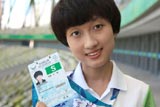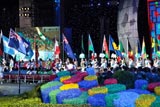Highlights of Shenzhen 2011 Summer Universiade
Updated: 2011-08-24 09:49
(Xinhua)
SHENZHEN, China - The 26th Summer Universiade drawn its curtain here on Tuesday night, concluding the 11 days competition among university athletes with memorable highlights.
Opening Ceremony
Shenzhen Sumer Universiade opened on August 12th, 12,000 student athletes, coaches and officials from 152 countries and regions started their journey here.
In the absence of famous pop stars and splendid fireworks show, the opening ceremony was massively different from the opening ceremonies of the 2008 Beijing Olympics and 2010 Guangzhou Asian Games.
Cutting off a long artistic performance, the parade of athletes was fully put back on track in Shenzhen, making it available for 12,000 delegates showing themselves at the opening ceremony.
The athletes also formed part of the stage, and they were invited to dance and sing with more than 4,000 young performers, making the ceremony a big party for, by and of the athletes.
First Gold Medalist
European Championships bronze medalist Simone Ruffini of Italy bagged the first gold medal in the 26th Summer Universiade on August 13th, by winning the men's 10 kilometers in open water, who clocked one hour 58 minutes 0.747 seconds for the title.
The first gold medal, as its symbolic significance, had always been a major event for the host country. So the first gold medalist had usually belonged to the host delegation by putting the most favorite event on top of the schedule.
Shenzhen Universiade broke with the tradition by arranging the first-day events more neutrally that the host athletes even could not win a medal at the Universiade opener.
Record Breakers
During the 11 days competition, 14 Universiade records have been refreshed by athletes from China, the U.S., Australia, South Korea and Lithuania on swimming, archery and cycling track.
Universiade swimmers broke 7 records, all by female athletes from China, the U.S. and Australia, while cycling track witnessed 6 records by athletes from China, Russia and Lithuania.
Jennifer Connolly, the U.S short course swimmer, broke the Universiade record at the heat of women's 50m backstroke and refreshed it again in the final. Lithuanian rider Vilijia Sereikaite was cast the same mould as Connolly to refresh the record twice for women's 3km individual pursuit.
Olympics Qualifiers
Thirty-eight swimmers from 16 countries and regions qualified for next year's London Olympic Games by hitting FINA's standards.
Swimming at Shenzhen Universiade was recognized as the official Olympics qualifying event by FINA. Individual swimmers who can meet the FINA standards of 2012 Olympic qualifying times in 26 events have the chance to swim in next year's Olympics.
The United States and Japan both have nine qualified swimmers to lead the list, yet only one American swimmer Michael Klueh made a double-spots in 400m free and 1,500m free while each of three Japanese swimmers, Satomi Suzuki, Yuya Horihata and Shiho Sakai won two qualifications.
Chinese Delegation
The Chinese delegation, consisting of 494 athletes, created the most splendid record in Universiade history.
Winning 75 golds, 39 silvers and 31 bronze medals, the host athletes harvested their major victories in track and field, diving and gymnastics.
However, China gave up their domination on some of their traditionally strong sports like badminton as they had not sent their best athletes, while focusing on sharing the happiness with athletes around the world has become the first priority.
Universiade Village
Home to more than 12,000 athletes and officials from 152 countries and regions around the world, the Shenzhen Universiade Village has become the largest, the most diverse cultured and the athletes village ever in Universiade history.
During the 12 days Universiade, more than 100 cultural activities was held. Merely in the Universiade village, around 80 live shows had been performed including fashion, music and drama. Apart from shows, the Cultural Experiencing Zone in the village also provided a favorable place for athletes to experience different cultures and communicate with others during the games.
Even in the delegation's meeting room, indoor performances had been hitting the stage every night, traditional Chinese dance, Shaolin Kungfu and acrobatics attracted many.
Green Legacy
Upon taking a closer look at some of the cars currently parked around Shenzhen, one can notice a rather unusual bumper sticker - a green ribbon. They aren't decorations, however, instead indicated the driver's willingness to spend less time on the road during the Universiade.
According to the organizing committee, more than 400,000 car owners volunteered to give up driving during the Universiade.
The host city also launched its own carbon-trading program earlier this month, and the money raised from these carbon sales will be used to plant trees, build energy saving-facilities and fund environmental research projects.
Video

Working as a Universiade volunteer

Party starts as Universiade ends

Sumptuous seafood in Shenzhen

Athletes test doping knowledge
About Shenzhen

